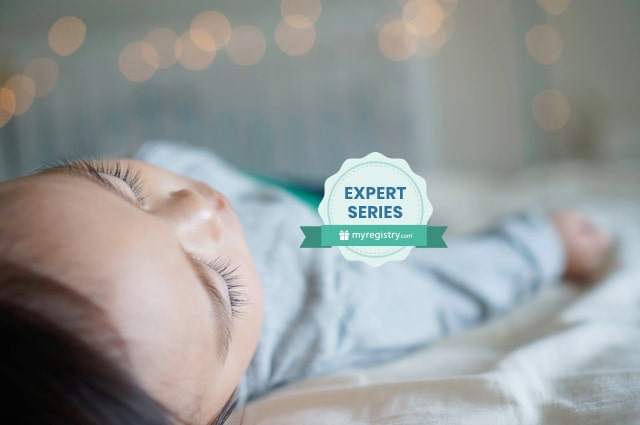
Sleep safety is among new parents' biggest concerns. The experts at the Juvenile Products Manufacturers Association offer tips to keep your little one safe and secure during nights and naptimes.
September is Baby Safety Month, and as part of our Expert Series, our partners at the Juvenile Products Manufacturers Association (JPMA) are joining us to share their expert advice on choosing and safely using the baby products you’ll need for your growing family. As the voice of the industry on quality and safety for baby and children’s products, for more than 40 years JPMA has helped parents feel confident in choosing safe products for their babies and children.
Poll any expectant or new parent about their biggest baby concerns, and sleep will most likely be at the top of the list. When you lay your little angel down for a nap or overnight sleep, you want to make sure he or she is safe. As part of Baby Safety Month, JPMA offers parents actionable safety tips to safely navigate through early childhood, including sleep safety.
Here are four ways you can help keep your little one safely dreaming:
Share Your Room, but Not Your Bed
It’s best for baby to be in your room for at least the first six months—and ideally the first year—as room sharing can decrease the risk of sudden infant death syndrome (SIDS) by as much as 50 percent, according to the American Academy of Pediatrics. This helps keep baby safer and makes those middle-of-the-night feedings and diaper changes easier. Place the crib, bassinet, or play yard close to your bed so you can easily feed, comfort, and keep a careful eye on baby. Only bring baby into your own bed to feed or comfort, and return them to their own sleep space when you’re ready to fall asleep.
Use a Firm Sleep Surface
The safest place for baby to sleep is in a bare, fully functional, properly assembled, JPMA-Certified crib. Before using a crib, check to make sure it has not been recalled, and consistently adhere to the manufacturer’s instructions and warning labels. In addition to keeping your baby’s sleep space bare, be sure they sleep on a firm mattress with a tight-fitting sheet. The mattress should fit snugly in your crib or bassinet, with no spaces between the two. Make sure there are no missing, loose, broken, or improperly installed screws, brackets, or other hardware on the crib or mattress support, and check the stability and hardware of the crib often. When your child is able to pull to a standing position, set the mattress to the lowest position and remove any objects that could serve as steps for climbing out.
Clear Out the Space
Approximately 3,500 infants in the U.S. die annually from sleep-related deaths, including sudden infant death syndrome, unexplainable deaths, and accidental suffocation or strangulation. It’s critical for baby to have a completely bare sleeping space. Whether it’s naptime or sleeping overnight, there shouldn’t be anything in or around the crib that could potentially suffocate or strangle them, including blankets, pillows, and stuffed animals. Sure, your nursery photos might look extra-cute with a quilt draped over the crib rail and a plush bear tucked into the corner, but when it’s time for baby to go to sleep, these items can put your little one at risk of suffocation, strangulation, and entrapment, and they should all be removed. Never place any item that has cords or strings in, on, or around the crib, as baby can become entangled and strangle in these items. If using a baby monitor with cords, make sure all cords are at least three feet away from the crib and out of arm’s reach of your child. Window blinds should be cordless, and mobiles should be removed from the crib when baby can push up on hands and knees or pull up to a standing position.
Back Is Best, and Keep It Cool
It doesn’t matter if you’re putting your child down for a nap or for the night—always place baby to sleep on their back, not their stomach, unless otherwise advised by a pediatrician. It’s natural to want to make sure baby is cozy and warm overnight, but studies show that sleeping in a hot room actually increases the risk of SIDS by around 4.5 percent. Keep the room temperature at 68–72 degrees Fahrenheit, and don’t overdress baby. If you feel like baby may become cold during sleep, use a wearable blanket or other sleep clothing as an alternative, and consider swaddling newborns.
For more sleep safety tips, visit https://www.jpma.org/page/parents.
Product Ideas for Sleep Safety
Below are a few sleep-related products that were selected as finalists and winners from the JPMA Innovation Awards in 2019 and 2020.
Find Something You Like?
You can add any of these items to your MyRegistry.com Baby Registry. Don’t have one yet? It’s easy! Create a Universal Baby Registry today, then add baby gifts from all your favorite stores.
Looking for More Baby Registry Ideas?
See more on our Baby Registry Inspiration Boards.
We are a Universal Gift Registry website where people can create a registry and add gifts from any store in the world. If you buy any of the products listed here, we may be compensated. Thanks for reading—we love you!